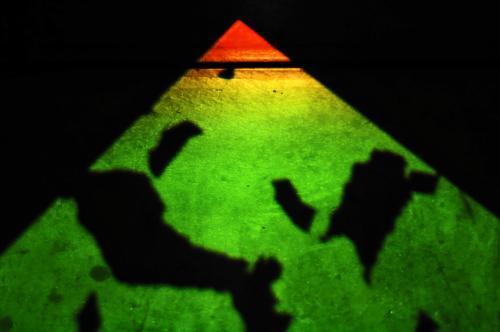
News
Cambridge Residents Slam Council Proposal to Delay Bike Lane Construction

News
‘Gender-Affirming Slay Fest’: Harvard College QSA Hosts Annual Queer Prom

News
‘Not Being Nerds’: Harvard Students Dance to Tinashe at Yardfest

News
Wrongful Death Trial Against CAMHS Employee Over 2015 Student Suicide To Begin Tuesday

News
Cornel West, Harvard Affiliates Call for University to Divest from ‘Israeli Apartheid’ at Rally
Paul Chan Deals with Difficult Subjects and ‘Three Easy Pieces’
Video artist discusses “Waiting for Godot” in New Orleans during recent talk

“A country road. A tree. Evening.”
Two men, dressed in tattered clothes, stand around, loitering, waiting. “Funny,” one says. “Nothing to be done.” Behind them glows an eerie light, the nighttime glare of the levee bordering the Ninth Ward of New Orleans.
“How could we use the most enigmatic play of the 20th century to talk about what happened in Katrina?” video artist Paul Chan remembers asking himself on a trip to New Orleans in the fall of 2006. His answer: a staging of Samuel Beckett’s “Waiting for Godot” in two devastated areas of the city. Beckett’s play, the story of two tramps waiting for a mysterious presence who never comes, puts into words the desolation of New Orleans and its residents. This 2007 project, a departure from Chan’s usual video installation work, was the focus of a talk last Thursday coinciding with the opening of his current exhibit, “Three Easy Pieces,” at the Carpenter Center.
“You could call this talk ‘Three Easy Pieces and One Really Hard Piece,’” he said.
The bare script of “Godot” allowed itself to be molded by the chaos of post-Katrina New Orleans. Describing the production, Chan recalled, “the bat...the cars, and the drunk guy screaming, ‘I’m waiting too!’” These stray sounds from the city helped settle Beckett’s spare script into its rough setting. “The silence of the play,” Chan said, “is a gift from Beckett. It’s a gift of space of silence that we can fill.”
The idea of emptiness runs through Chan’s visual work. In “5th Light,” one of Chan’s “easy” pieces, shadows projected on the floor float in a triangle of light. Like the bare text of “Godot,” the shadows allow the viewer to access something that cannot be faced straightforwardly. “Some things we simply cannot look at directly,” Chan said, but with shadows, “we learn what it means to not look at something directly and feel it too.”
When working in New Orleans, Chan wasn’t satisfied with simply putting on a performance. He wanted to revive the damaged communities through art. In collaboration with the New York public art group Creative Time and the Classical Theatre of Harlem, Chan established a network of art institutions that could outlive the “Godot” production itself. He moved to New Orleans for the entire fall semester in order to build his project from the bottom up. Chan taught classes at local universities and set up art workshops with New Orleans high school students. He even arranged potluck dinners for people in the neighborhoods where he would later stage the play. These dinners allowed Chan and his collaborators to discuss specifics of the performance, such as setting and themes, with his future audience. “This is how we got all our ideas,” he said.
Chan described his networking through humorous portraits of the community members who helped him in his project. “Neighborhood ambassador” Robert Green, a New Orleans citizen whose FEMA trailer stood in the middle of the Ninth Ward as a memorial to family members lost in the flood, was instrumental in helping Chan.
“[Green] didn’t know who the hell Godot was,” Chan said, “and he didn’t care.” When Green refused to join the project, Chan gave him a copy of “Godot.” The next morning, Chan received a phone call. “There was a man screaming on line,” he said. “He yelled, ‘Let’s not waste time in idle discourse,’ a line from the play.”
Chan has combined politics with art in the past. “Baghdad in No Particular Order,” currently at the Carpenter Center, stemmed from a trip he made to the city on the eve of the second Iraq war. Traveling with a group of anti-war activists, Chan filmed the effects of sanctions on everyday life. The footage surveys citizens of the city: artists drinking tea in a café, twin girls dancing in their living room, a man listening to an Arabic cover of “I Will Always Love You” as he drives through the barren Iraqi land. The colors are muted and hushed, as if curbed by the sanctions as well.
For Chan, both experiences are connected. He pointed to an image on the screen—a white-washed New Orleans house smeared with the word “Baghdad.” The author of that graffiti, he said, “understood that the same logic of criminal neglect that gave us New Orleans gave us the Iraq war.”
Though Chan does not plan to put on more theatrical productions in the future, working on “Godot” has made it difficult to return to visual art. “It is hard to recover from it,” he said. Still, he doesn’t want to dwell on the project for much longer; he’s afraid of receiving a letter from the Beckett estate reading, “You have used Beckett too many times. You owe Beckett $12,000.”
Want to keep up with breaking news? Subscribe to our email newsletter.
